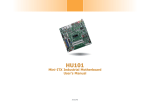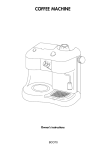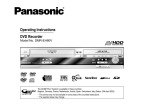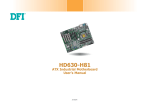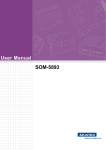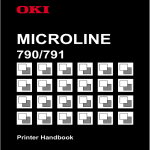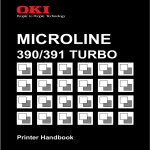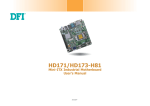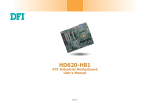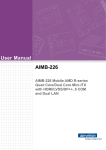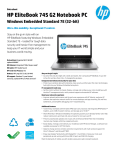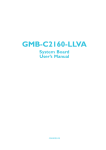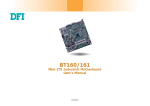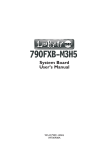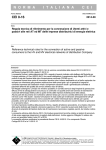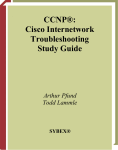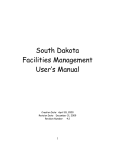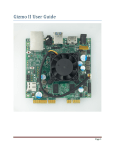Download Manual - DFI Inc.
Transcript
BE170/BE171/BE173
Mini-ITX Industrial Motherboard
User’s Manual
A35200522
1
Copyright
FCC and DOC Statement on Class B
This publication contains information that is protected by copyright. No part of it may be reproduced in any form or by any means or used to make any transformation/adaptation without
the prior written permission from the copyright holders.
This equipment has been tested and found to comply with the limits for a Class B digital
device, pursuant to Part 15 of the FCC rules. These limits are designed to provide reasonable protection against harmful interference when the equipment is operated in a residential
installation. This equipment generates, uses and can radiate radio frequency energy and, if not
installed and used in accordance with the instruction manual, may cause harmful interference
to radio communications. However, there is no guarantee that interference will not occur in a
particular installation. If this equipment does cause harmful interference to radio or television
reception, which can be determined by turning the equipment off and on, the user is encouraged to try to correct the interference by one or more of the following measures:
This publication is provided for informational purposes only. The manufacturer makes no
representations or warranties with respect to the contents or use of this manual and specifically disclaims any express or implied warranties of merchantability or fitness for any particular
purpose. The user will assume the entire risk of the use or the results of the use of this document. Further, the manufacturer reserves the right to revise this publication and make changes
to its contents at any time, without obligation to notify any person or entity of such revisions
or changes.
•
•
•
Changes after the publication’s first release will be based on the product’s revision. The website
will always provide the most updated information.
•
Reorient or relocate the receiving antenna.
Increase the separation between the equipment and the receiver.
Connect the equipment into an outlet on a circuit different from that to which the receiver
is connected.
Consult the dealer or an experienced radio TV technician for help.
© 2015. All Rights Reserved.
Notice:
Trademarks
1. The changes or modifications not expressly approved by the party responsible for compliance could void the user’s authority to operate the equipment.
2. Shielded interface cables must be used in order to comply with the emission limits.
Product names or trademarks appearing in this manual are for identification purpose only and
are the properties of the respective owners.
2
Table of Contents
ATX Power Connector ................................................................................. 24
S/PDIF Connector ....................................................................................... 25
Expansion Slots .......................................................................................... 25
Chassis Intrusion Connector ........................................................................ 26
LPC Connector ............................................................................................ 26
Standby Power LED .................................................................................... 27
Battery ....................................................................................................... 27
Copyright............................................................................................................. 2
Trademarks ........................................................................................................ 2
FCC and DOC Statement on Class B ..................................................... 2
Chapter 3 - BIOS Setup ............................................................... 28
About this Manual .......................................................................................... 4
Warranty
Overview ..................................................................................................... 28
AMI BIOS Setup Utility ............................................................................. 29
............................................................................................................ 4
Static Electricity Precautions...................................................................... 4
Main .......................................................................................................... 29
Advanced ................................................................................................... 29
Chipset ...................................................................................................... 40
Boot........................................................................................................... 43
Security...................................................................................................... 44
Save & Exit ................................................................................................ 44
Safety Measures .............................................................................................. 4
About the Package ......................................................................................... 5
Chapter 1 - Introduction ............................................................................. 6
Updating the BIOS .................................................................................... 45
Specifications ................................................................................................ 6
Features .......................................................................................................... 7
Chapter 4 - Supported Software ........................................................... 46
Chapter 5 - Digital I/O Programming Guide.................................... 56
Chapter 2 - Hardware Installation................................................ 9
Appendix A - Watchdog Sample Code................................................ 58
Board Layout ................................................................................................. 9
System Memory ............................................................................................ 9
Appendix B - System Error Message ................................................... 59
Installing the DIMM Module ........................................................................ 10
Appendix C - Troubleshooting ................................................................ 60
Jumper Settings ......................................................................................... 11
Clear CMOS Data ........................................................................................ 11
Auto Power-on Select.................................................................................. 12
USB Power Select ....................................................................................... 12
COM 1 RS232/422/485 Select ..................................................................... 13
SATA DOM Power Select ............................................................................. 14
Digital I/O Power Select .............................................................................. 14
Digital I/O Output State .............................................................................. 15
Mini PCIe Signal Select ............................................................................... 15
Mini PCIe Power Select ............................................................................... 16
Rear Panel I/O Ports ................................................................................. 17
12V DC-in (BE171)/19~24V DC-in (BE173) .................................................. 17
Graphics Interfaces ..................................................................................... 18
RJ45 LAN Ports........................................................................................... 18
USB Ports ................................................................................................... 19
Audio ......................................................................................................... 20
I/O Connectors ........................................................................................... 20
SATA (Serial ATA) Connectors ...................................................................... 20
SATA (Serial ATA) Power Connectors - BE171/BE173 .................................... 21
Digital I/O Connector .................................................................................. 21
Digital I/O Power Connector ........................................................................ 21
Cooling Fan Connectors............................................................................... 22
Front Panel Connector ................................................................................ 22
COM (Serial) Ports ...................................................................................... 23
SMBus Connector ....................................................................................... 24
3
About this Manual
Static Electricity Precautions
An electronic file of this manual is included in the CD. To view the user’s manual in the CD,
insert the CD into a CD-ROM drive. The autorun screen (Main Board Utility CD) will appear.
Click “User’s Manual” on the main menu.
It is quite easy to inadvertently damage your PC, system board, components or devices even
before installing them in your system unit. Static electrical discharge can damage computer
components without causing any signs of physical damage. You must take extra care in handling them to ensure against electrostatic build-up.
1. To prevent electrostatic build-up, leave the system board in its anti-static bag until you are
ready to install it.
Warranty
2. Wear an antistatic wrist strap.
1. Warranty does not cover damages or failures that arised from misuse of the product,
inability to use the product, unauthorized replacement or alteration of components and
product specifications.
3. Do all preparation work on a static-free surface.
4. Hold the device only by its edges. Be careful not to touch any of the components, contacts
or connections.
2. The warranty is void if the product has been subjected to physical abuse, improper installation, modification, accidents or unauthorized repair of the product.
5. Avoid touching the pins or contacts on all modules and connectors. Hold modules or connectors by their ends.
3. Unless otherwise instructed in this user’s manual, the user may not, under any circumstances, attempt to perform service, adjustments or repairs on the product, whether in or
out of warranty. It must be returned to the purchase point, factory or authorized service
agency for all such work.
Important:
Electrostatic discharge (ESD) can damage your processor, disk drive and other components. Perform the upgrade instruction procedures described at an ESD workstation only. If such a station is not available, you can provide some ESD protection by
wearing an antistatic wrist strap and attaching it to a metal part of the system chassis. If a wrist strap is unavailable, establish and maintain contact with the system
chassis throughout any procedures requiring ESD protection.
4. We will not be liable for any indirect, special, incidental or consequencial damages to the
product that has been modified or altered.
Safety Measures
To avoid damage to the system:
• Use the correct AC input voltage range.
To reduce the risk of electric shock:
• Unplug the power cord before removing the system chassis cover for installation or servicing. After installation or servicing, cover the system chassis before plugging the power
cord.
4
About the Package
The package contains the following items. If any of these items are missing or damaged,
please contact your dealer or sales representative for assistance.
•
•
•
•
•
•
•
One
One
One
One
One
One
One
BE170/BE171/BE173 motherboard
Serial ATA data cable - BE170
Serial ATA data with power cable - BE171/BE173
I/O Shield
DVD
QR (Quick Reference)
Cooler
The board and accessories in the package may not come similar to the information listed
above. This may differ in accordance to the sales region or models in which it was sold. For
more information about the standard package in your region, please contact your dealer or
sales representative.
Optional Items
•
•
•
•
•
•
•
USB port cable
COM port cable
Serial ATA data cable - BE170
Serial ATA data with power cable - BE171/BE173
I/O Shield
Power adapter (100W, 12V) - BE171
Power adapter (120W, 19V) - BE173
The board and accessories in the package may not come similar to the information listed
above. This may differ in accordance to the sales region or models in which it was sold. For
more information about the standard package in your region, please contact your dealer or
sales representative.
Before Using the System Board
Before using the system board, prepare basic system components.
If you are installing the system board in a new system, you will need at least the following
internal components.
•
•
Memory module
Storage devices such as hard disk drive, CD-ROM, etc.
You will also need external system peripherals you intend to use which will normally include at
least a keyboard, a mouse and a video display monitor.
5
Chapter 1
Chapter 1 - Introduction
Specifications
Processor
• 2nd Generation
AMD® Embedded R-Series APU FP3 BGA
AMD® RX-427BB, Quad Core, 4M Cache, 2.7GHz (3.6GHz), 35W
AMD® RX-225FB, Dual Core, 1M Cache, 2.2GHz (3.0GHz), 17W
(The following specifications will be available upon request. Please contact
your sales representative
for more information.)
425B: AMD® RX-425BB, Quad Core, 4M Cache, 2.5GHz (3.4GHz), 35W
• 28nm process technology
Chipset
• AMD® A77E Fusion Controller Hub
Super I/O
Address
• NCT6106/4Eh
System Memory
•
•
•
•
•
Expansion
Interfaces
• 1 PCIe x16/x8 Gen 3 slot (PCIe 3.0)
- 1 x16 signal (Gen 3) (Quad Core APU)
- 1 x8 signal (Gen 3) (Dual Core APU)
• 1 Mini PCIe slot
- Supports USB and PCIe signals
- Supports mSATA
- Supports half size and/or full size Mini PCIe card
Two 204-pin SODIMM sockets
Supports DDR3/DDR3L 1600/1866/2133MHz
Supports up to 16GB system memory
Supports dual channel memory interface
DRAM device technologies: 1Gb, 2Gb and 4Gb DDR3 DRAM technologies are
supported for x8 and x16 devices, unbuffered, non-ECC
Graphics
• AMD RadeonTM HD 9000 Series Graphics
• Display ports: 4 DP (supports DP++)
• DP: resolution up to 3840x2160 @ 30Hz
• Supports hardware acceleration for DirectX 11.1, OCL 1.2, OGL 4.1/4.1+, H.264,
VC-1, MPEG-4, MPEG-2 and WMV
Audio
• Realtek ALC888 7.1-channel High Definition Audio
• S/PDIF audio interface
LAN
• 1 Intel® I210 PCI Express Gigabit Ethernet controller
• 1 Realtek RTL8111EP Ethernet controller
- supports DASH for remote management
• Integrated 10/100/1000 transceiver
• Fully compliant with IEEE 802.3, IEEE 802.3u, IEEE 802.3ab
Serial ATA
• 4 SATA 3.0 ports with data transfer rate up to 6Gb/s
- SATA port 0 provides adequate space for SATA DOM
• Integrated Advanced Host Controller Interface (AHCI) controller
Trusted
Platform
Module - TPM*
(optional)
• Provides a Trusted PC for secure transactions
• Provides software license protection, enforcement and password protection
Rear Panel I/O
Ports
• 1 12V (BE171) or 19~24V (BE173) DC-in jack
or 4-pin power connector* (optional)
• 4 DP ports
• 2 RJ45 LAN ports
• 4 USB 3.0 ports
• Mic-in, Line-in and Line-out jacks
I/O Connectors
• 2 connectors for 4 external USB 2.0/1.1 ports
• 1 vertical USB 2.0/1.1 port
• 4 connectors for 4 external serial ports (2.0mm pitch)
- 1 RS232/422/485
- 3 RS232
• 1 8-bit DIO connector
• 1 Digital I/O power connector
• 1 front audio connector for line-out and mic-in jacks
• 1 S/PDIF connector
• 1 LAN LED connector* (optional)
• 1 LPC connector
• 1 SMBus connector
• 4 Serial ATA connectors
• 4 Serial ATA power connectors - BE171/BE173
• 1 24-pin ATX power connector - BE170
• 1 front panel connector
• 1 chassis intrusion connector
• 2 fan connectors
WatchDog Timer
• Watchdog timeout programmable via software from 1 to 255 seconds
BIOS
• AMI BIOS
- 64Mbit SPI BIOS
Energy Efficient
Design
•
•
•
•
Damage Free
Intelligence
• Monitors APU/system temperature and overheat alarm
• Monitors APU_VDD/APU_VDDNB/APU_VDDIO_SUS/+12V voltages and failure
alarm
• Monitors APU/system fan speed and failure alarm
• Read back capability that displays temperature, voltage and fan speed
Power
Consumption
• BE170-77EN-427B: 38.06W with RX-427BB at 2.7GHz and 2x 4GB DDR3L
SODIMM
• BE171-77EN-427B: 49.66W with RX-427BB at 2.7GHz and 2x 4GB DDR3L
SODIMM
• BE173-77EN-427B: 41.04W with RX-427BB at 2.7GHz and 2x 4GB DDR3L
SODIMM
OS Support
• Windows 7 Ultimate x86 & SP1 (32-bit)
• Windows 7 Ultimate x64 & SP1 (64-bit)
• Windows 8.1 Embedded Pro x64 (64-bit)
Temperature
• Operating: 0oC to 60oC
• Storage: -20oC to 85oC
Humidity
• 10% to 95%
Dimensions
• Mini-ITX form factor
• 170mm (6.7") x 170mm (6.7")
Supports ErP Lot6 power saving* (optional)
Supports ACPI
System Power Management
Wake-On-Events include:
- Wake-On-USB KB/Mouse
- Wake-On-LAN
- RTC timer to power-on the system
• AC power failure recovery
Note:
*Optional and is not supported in standard model. Please contact your sales representative for more information.
6
Chapter 1 Introduction
www.dfi.com
Chapter 1
Features
• Wake-On-LAN
• Watchdog Timer
This feature allows the network to remotely wake up a Soft Power Down (Soft-Off) PC. It is
supported via the onboard LAN port or via a PCI LAN card that uses the PCI PME (Power Management Event) signal. However, if your system is in the Suspend mode, you can power-on the
system only through an IRQ or DMA interrupt.
The Watchdog Timer function allows your application to regularly “clear” the system at the set
time interval. If the system hangs or fails to function, it will reset at the set time interval so
that your system will continue to operate.
Important:
The 5V_standby power source of your power supply must support ≥720mA.
• DDR3
DDR3 delivers increased system bandwidth and improved performance. The advantages of
DDR3 are its higher bandwidth and its increase in performance at a lower power than DDR2.
• Wake-On-USB
• Graphics
This function allows you to use a USB keyboard or USB mouse to wake up a system from the
S3 (STR - Suspend To RAM) state.
The integrated AMD® RadeonTM dual graphics engine delivers an excellent blend of graphics
performance and features to meet business needs. It provides excellent video and 3D graphics
with outstanding graphics responsiveness. These enhancements deliver the performance and
compatibility needed for today’s and tomorrow’s business applications. Supports 4 DP interfaces for display outputs.
Important:
If you are using the Wake-On-USB Keyboard/Mouse function for 2 USB ports, the
5V_standby power source of your power supply must support ≥1.5A. For 3 or more
USB ports, the 5V_standby power source of your power supply must support ≥2A.
• Serial ATA
Serial ATA is a storage interface that is compliant with SATA 1.0a specification. With speed of
up to 6Gb/s (SATA 3.0), it improves hard drive performance faster than the standard parallel
ATA whose data transfer rate is 100MB/s.
• RTC Timer
• Gigabit LAN
The RTC installed on the system board allows your system to automatically power-on on the
set date and time.
One Intel I210 PCI Express Gigabit Ethernet controller and one Realtek RTL8111EP Ethernet
controller support up to 1Gbps data transmission.
®
• ACPI STR
• Audio
The system board is designed to meet the ACPI (Advanced Configuration and Power Interface)
specification. ACPI has energy saving features that enables PCs to implement Power Management and Plug-and-Play with operating systems that support OS Direct Power Management.
ACPI when enabled in the Power Management Setup will allow you to use the Suspend to RAM
function.
The Realtek ALC888 audio codec provides 7.1-channel High Definition audio output.
• PCI Express
PCI Express is a high bandwidth I/O infrastructure that possesses the ability to scale speeds
by forming multiple lanes. The PCI Express architecture supports high performance graphics
infrastructure by enhancing the capability of a PCIe x16 Gen 3 at 16GB/s bandwidth (8GB/s in
each direction).
With the Suspend to RAM function enabled, you can power-off the system at once by pressing
the power button or selecting “Standby” when you shut down Windows® without having to
go through the sometimes tiresome process of closing files, applications and operating system.
This is because the system is capable of storing all programs and data files during the entire
operating session into RAM (Random Access Memory) when it powers-off. The operating session will resume exactly where you left off the next time you power-on the system.
7
Chapter 1 Introduction
www.dfi.com
Chapter 1
• USB
The system board supports the new USB 3.0. It is capable of running at a maximum transmission speed of up to 5 Gbit/s (625 MB/s) and is faster than USB 2.0 (480 Mbit/s, or 60 MB/s)
and USB 1.1 (12Mb/s). USB 3.0 reduces the time required for data transmission, reduces
power consumption, and is backward compatible with USB 2.0. It is a marked improvement
in device transfer speeds between your computer and a wide range of simultaneously
accessible external Plug and Play peripherals.
Important:
The 5V_standby power source of your power supply must support ≥720mA.
• Power Failure Recovery
When power returns after an AC power failure, you may choose to either power-on the system
manually or let the system power-on automatically.
8
Chapter 1 Introduction
www.dfi.com
Chapter 2
Chapter 2 - Hardware Installation
Important:
Electrostatic discharge (ESD) can damage your board, processor, disk drives, add-in
boards, and other components. Perform installation procedures at an ESD workstation
only. If such a station is not available, you can provide some ESD protection by wearing an antistatic wrist strap and attaching it to a metal part of the system chassis. If
a wrist strap is unavailable, establish and maintain contact with the system chassis
throughout any procedures requiring ESD protection.
Board Layout
SATA
Power 3
SATA
Power 2
SATA
Power 1
SATA
Power 0
4
4
4
4
1
1
Note:
SATA 0 supports SATA DOM.
USB 3.0 0-1 Power
Select (JP8)
4-pin power (optional)
SATA 3.0
SATA 2 SATA 1
SATA 3
Standby
Power LED
DC-in
1
1
1
Auto Power-on
Select (JP15)
13 1
1
SATA 0
1
1 2
1
Front
Panel
(JP15)
1
1
System Memory
11 12
2
1
Intel
WGI210AT
USB 3.0
SMBus
1
ATX Power
Battery
6
5
(JP14)
1
Clear CMOS
Data (JP1)
SATA DOM Power
Select (JP2)
1
(JP12)
1
Mini PCIe
3
COM 3
1
Mini PCIe Signal
Select (JP6)
1
COM 4
2
10
2
1
9
1
9
2
10
2
10
1
9
1
9
1
1
SPI Flash
BIOS
USB 2.0 0-1/2-3
Power Select (JP10)
USB 2-3
USB 0-1
4 USB 2.0 2
10
2
10 USB 2.0
USB 5
10
1
9
1
DP 2-3
1
2
5
1
6
2
USB 2.0 5 Power
Select (JP11)
5
1
6
2
R-Series
LPC
(JP3)
DDR3-2
DDR3-1
21
6
1
AMD
1211
(JP5)
5
System Fan 1
COM 1
(JP4)
RS232/422/485 (JP5)
Select
(JP3)
(JP4)
Standby
Power LED
9
COM 1
COM 2
Digital I/O
Power
DIO Power Select (JP12)
DIO 0-3 Output State (JP13)
DIO 4-7 Output State (JP14)
A77E
12 10
1
24 12
DDR3_1 SODIMM
1
DP 0-1
(JP13)
AMD
Mini PCIe Power
Select (JP7)
USB 3.0
Important:
When the Standby Power LED lights red, it indicates that there is power on the system board. Power-off the PC then unplug the power cord prior to installing any devices. Failure to do so will cause severe damage to the motherboard and components.
1
USB 3.0 2-3 Power
Select (JP9)
LAN 2
USB 2-3
Digital
I/O
1
DDR3_2 SODIMM
LAN 1
USB 0-1
Rear I/O
Chassis
Intrusion
Onboard I/O
12
Line-in
Line-out
Mic-in
1
Front
Audio
9 10
Storage
CPU Fan
S/PDIF
1
Buzzer
Expansion
Realtek
ALC888
Features
PCIe x16
•
BE170 is not equipped with DC-in jack.
•
BE171: 12V DC-in jack (default) or 4-pin power connector (optional).
BE173: 19~24V DC-in jack (default) or 4-pin power connector (optional).
•
SATA power connectors are populated on BE171 and BE173 only.
•
24-pin ATX power connector is populated on BE170 only.
•
Two 204-pin DDR3 SODIMM sockets
•
Supports 1600/1866/2133MHz
•
Supports up to 16GB system memory
•
Supports dual channel memory interface
9
Chapter 2 Hardware Installation
www.dfi.com
Chapter 2
Installing the DIMM Module
The system board supports the following memory interface.
Note:
The system board used in the following illustrations may not resemble the actual
board. These illustrations are for reference only.
Single Channel (SC)
Data will be accessed in chunks of 64 bits (8B) from the memory channels.
Dual Channel (DC)
1. Make sure the PC and all other peripheral devices connected to it has been powered down.
Data will be accessed in chunks of 128 bits from the memory channels. Dual channel provides
better system performance because it doubles the data transfer rate.
2. Disconnect all power cords and cables.
3. Locate the DIMM socket on the system board.
Single Channel
Dual Channel
DIMMs are on the same channel.
DIMMs in a channel can be identical or
completely different. However, we highly
recommend using identical DIMMs.
Not all slots need to be populated.
4. Push the “ejector tabs” which are at the ends of the socket to the side.
Ejector tab
Ejector tab
DIMMs of the same memory configuration
are on different channels.
5. Note how the module is keyed to the socket.
Notch
Key
10
Chapter 2 Hardware Installation
www.dfi.com
Chapter 2
Jumper Settings
6. Grasping the module by its edges, position the module above the socket with the “notch”
in the module aligned with the “key” on the socket. The keying mechanism ensures the
module can be plugged into the socket in only one way.
Clear CMOS Data
1 2 3
JP1
1-2 On:
Normal (default)
1 2 3
7. Seat the module vertically, pressing it down firmly until it is completely seated in the
socket. The ejector tabs at the ends of the socket will automatically snap into the locked
position to hold the module in place.
2-3 On:
Clear CMOS Data
If you encounter the following,
a) CMOS data becomes corrupted.
b) You forgot the supervisor or user password.
you can reconfigure the system with the default values stored in the ROM BIOS.
To load the default values stored in the ROM BIOS, please follow the steps below.
1. Power-off the system and unplug the power cord.
2. Set JP1 pins 2 and 3 to On. Wait for a few seconds and set JP1 back to its default setting,
pins 1 and 2 On.
3. Now plug the power cord and power-on the system.
11
Chapter 2 Hardware Installation
www.dfi.com
Chapter 2
Auto Power-on Select
USB Power Select
JP15
1
2
3
1-2 On:
Power-on via power button
(default)
1 2 3
1 2 3
1-2 On: +5V
(default)
2-3 On:
+5V_standby
USB 3.0 0-1
(JP8)
1
2
3
2-3 On:
Power-on via AC power
1
2
3
1-2 On: +5V
(default)
1
2
3
USB 2.0 0-1/2-3
(JP10)
USB 3.0 2-3
(JP9)
USB 2.0 5
(JP11)
2-3 On:
+5V_standby
JP15 is used to select the method of powering on the system. If you want the system to
power-on whenever AC power comes in, set JP15 pins 2 and 3 to On. If you want to use the
power button, set pins 1 and 2 to On.
When using the JP15 “Power On” feature to power the system back on after a power failure
occurs, the system may not power on if the power lost is resumed within 5 seconds (power
flicker).
JP8, JP9, JP10 and JP11 are used to select the power of the USB ports. Selecting +5V_standby
will allow you to use a USB device to wake up the system.
Important:
If you are using the Wake-On-USB Keyboard/Mouse function for 2 USB ports, the
+5V_standby power source of your power supply must support ≥1.5A. For 3 or more
USB ports, the +5V_standby power source of your power supply must support ≥2A.
12
Chapter 2 Hardware Installation
www.dfi.com
Chapter 2
COM 1 RS232/422/485 Select
RXDTXDNC.
NC.
RXD
DTRDSRCTS-
2
1
2
1
9
9
DATA+
TXD
NC.
NC.
NC.
DCDTXD
GND
RTSRI-
9
RXD+
TXD+
NC.
NC.
NC.
2
1
RS422
Full Duplex
RS232
RS485
JP3
COM 1: RS232/422/485
2
1
DATANC.
NC.
NC.
COM 1
1
3
5
9
JP4
JP5
JP3
2
4
6
1-2 On: RS232
(default)
1
3
5
2
4
6
2
4
6
5-6 On: RS485
1
3
5
3-4 On: RS422
Full Duplex
JP4 and JP5
1
3
5
2
4
6
1-3, 2-4 On:
RS232 (default)
JP3, JP4 and JP5 allow you to configure the Serial COM port 1 to RS232, RS422 (Full Duplex)
or RS485. The pin functions of Serial COM port 1 will vary according to these jumpers’ setting.
1
3
5
2
4
6
3-5, 4-6 On:
RS422 Full Duplex/RS485
Note:
When COM 1 RS232/422/485 is selected, JP4 and JP5 must be set in accordance to
JP3.
13
Chapter 2 Hardware Installation
www.dfi.com
Chapter 2
SATA DOM Power Select
Digital I/O Power Select
SATA 0
JP12
JP2
1
2
3
1-2 On: +5V_standby
(default)
1 2 3
1-2 On: GND (default)
1
2
3
2-3 On: +5V
1 2 3
2-3 On: +5V
JP2 is used to select the power level of SATA DOM.
JP12 is used to select the power of DIO (Digital I/O) signal.
Note:
SATA port 0 provides adequate space for SATA DOM.
14
Chapter 2 Hardware Installation
www.dfi.com
Chapter 2
Digital I/O Output State
Mini PCIe Signal Select
DIO 4-7
(JP14)
DIO 0-3
(JP13)
12
10
3
1
1
2
3
1-2 On: +5V or
+5V_standby
(default)
1-4-7-10, 2-5-8-11 On:
PCIe (default)
1
2
3
12
10
JP6
2-3 On: GND
1
3
2-5-8-11, 3-6-9-12 On:
mSATA
Based on the power level of DIO (Digital I/O) selected on JP12, JP13 (DIO pin 0-3) and JP14
(DIO pin 4-7) are used to select the state of DIO output: pull high or pull low. When selecting
pull high, the power selection will be the same as JP12’s setting.
JP6 is used to select the Mini PCIe signal: PCIe or mSATA.
15
Chapter 2 Hardware Installation
www.dfi.com
Chapter 2
Mini PCIe Power Select
1 2 3
1-2 On: +3.3V_standby (Mini PCIe)
(default)
JP7
1 2 3
2-3 On: +3.3V (mSATA)
JP7 is used to select the power supplied with the Mini PCIe.
16
Chapter 2 Hardware Installation
www.dfi.com
Chapter 2
Rear Panel I/O Ports
12V DC-in (BE171)/19~24V DC-in (BE173)
DC-in
LAN 1
LAN 2
DP 1
DP 3
Line-in
Line-out
DC-in
Mic-in
USB 3.0
USB 3.0
DP 0
DP 2
The rear panel I/O ports consist of the following:
•
•
•
•
•
•
•
1 12V (BE171) or 19~24V (BE173) DC-in jack or 4-pin power connector* (optional)
4 DP ports
2 RJ45 LAN ports
4 USB 3.0 ports
Line-in jack
Line-out jack
Mic-in jack
This jack provides maximum of 100W/120W power and is considered a low power solution.
Connect a DC power cord to this jack. Use a power adapter with 12V (for BE171) or 19~24V
(for BE173) DC output voltage. Using a voltage higher than the recommended one may fail to
boot the system or cause damage to the system board.
The 12V (for BE171) or 19~24V (for BE173) DC-in jack on the system board co-lays with a
4-pin power connector (optional) as the figure displayed below.
4-pin Power
1 3
+12V
Ground
Ground
2 4
DC-in jack
+12V
17
Chapter 2 Hardware Installation
www.dfi.com
Chapter 2
Graphics Interfaces
RJ45 LAN Ports
The display ports consist of the followings:
•
4 DP ports
LAN 1
DP 1
DP 3
LAN 2
LAN 1
LAN 2
DP 0-1
DP 2-3
DP 0
DP 2
Features
• 1 Intel® I210 PCI Express Gigabit Ethernet controller
DP Port
• 1 Realtek RTL8111EP Ethernet controller
- supports DASH for remote management
The DP port is a digital display interface used to connect a display device such as a computer
monitor. It is used to transmit audio and video simultaneously. The interface, which is developed by VESA, delivers higher performance features than any other digital interface.
The two LAN ports allow the system board to connect to a local area network by means of a
network hub.
18
Chapter 2 Hardware Installation
www.dfi.com
Chapter 2
USB Ports
Wake-On-USB Keyboard/Mouse
The Wake-On-USB Keyboard/Mouse function allows you to use a USB keyboard or USB mouse
to wake up a system from the S3 (STR - Suspend To RAM) state. To use this function:
•
USB 1
USB 3
USB 0
USB 2
USB 3.0
Jumper Setting
JP8, JP9, JP10 and JP11 must be set to “2-3 On: +5V_standby”. Refer to “USB Power Select”
in this chapter for more information.
USB 3.0
USB 5
GND
-Data
+Data
VCC
1
4
USB 2.0
USB 0-1
Key
GND
+Data
-Data
VCC
USB 2-3
10
9
N.C.
GND
+Data
-Data
VCC
USB 2.0 2
1
The USB device allows data exchange between your computer and a wide range of simultaneously accessible external Plug and Play peripherals.
The system board is equipped with four onboard USB 3.0 ports (USB 0-1/2-3) and one vertical
USB 2.0 port (USB 5) for security drive. The 10-pin connectors allow you to connect 4 additional USB 2.0 ports (USB 0-1/2-3). The additional USB ports may be mounted on a card-edge
bracket. Install the card-edge bracket to an available slot at the rear of the system chassis and
then insert the USB port cables to a connector.
19
Chapter 2 Hardware Installation
www.dfi.com
Chapter 2
I/O Connectors
Audio
SATA (Serial ATA) Connectors
SATA 3 SATA 2 SATA 1 SATA 0
Rear audio
SATA 2.0 3Gb/s
Line-in
GND 1
TXP
TXN
GND
RXN
RXP
GND
7
Line-out
Mic-in
Front Audio
Rear Audio
Mic2-L
Mic2-R
Line2-R
GND
Line2-L
12
GND
NC
Mic2-JD
Key
Line2-JD
Features
9 10
The system board is equipped with 3 audio jacks. A jack is a one-hole connecting interface for
inserting a plug.
•
•
•
Line-in Jack (Light Blue)
This jack is used to connect any audio devices such as Hi-fi set, CD player, tape player,
AM/FM radio tuner, synthesizer, etc.
•
4 Serial ATA 3.0 ports with data transfer rate up to 6Gb/s
•
Integrated Advanced Host Controller Interface (AHCI) controller
The Serial ATA connectors are used to connect Serial ATA devices. Connect one end of the Serial
ATA data cable to a SATA connector and the other end to your Serial ATA device.
Line-out Jack (Lime)
This jack is used to connect a headphone or external speakers.
Note:
SATA port 0 provides adequate space for SATA DOM.
Mic-in Jack (Pink)
This jack is used to connect an external microphone.
Front Audio
The front audio connector allows you to connect to the second line-out and mic-in jacks that
are at the front panel of your system.
20
Chapter 2 Hardware Installation
www.dfi.com
Chapter 2
SATA (Serial ATA) Power Connectors -BE171/BE173
Digital I/O Connector
Digital I/O Power Connector
4
1
+5V
Ground
Ground
+12V
SATA SATA
Power 2 Power 1
SATA
SATA
Power 3
Power 0
Digital I/O
Digital I/O power
1
4
+12V
Ground
+5V_standby
+5V
The 8-bit Digital I/O connector provides powering-on function to external devices that are connected to these connectors.
Digital I/O Connector
The SATA power connectors supply power to the SATA drive. Connect one end of the provided
power cable to the SATA power connector and the other end to your storage device.
Pins
Function
0
DIO7
1
DIO6
2
DIO5
3
DIO4
4
DIO3
5
DIO2
6
DIO1
7
DIO0
21
Chapter 2 Hardware Installation
www.dfi.com
Chapter 2
Cooling Fan Connectors
Front Panel Connector
1 2
Front
Panel
PWR-LED
HDD-LED
PWR-BTN
RESET-SW
Ground
Power
Sense
11 12
1
3
System Fan
HDD-LED - HDD LED
Ground
Power
Sense
This LED will light when the hard drive is being accessed.
1
RESET-SW - Reset Switch
This switch allows you to reboot without having to power off the system.
PWR-BTN - Power Switch
3
This switch is used to power on or off the system.
CPU Fan
PWR-LED - Power/Standby LED
The fan connectors are used to connect cooling fans. The cooling fans will provide adequate
airflow throughout the chassis to prevent overheating the CPU and system board components.
When the system’s power is on, this LED will light. When the system is in the S1 (POS - Power
On Suspend) state, it will blink every second. When the system is in the S3 (STR - Suspend To
RAM) state, it will blink every 4 seconds.
Pin Pin Assignment
HDD-LED
RESET-SW
3
HDD Power
5
Signal
7
Ground
9
RST Signal
11
N.C.
Pin Pin Assignment
2
LED Power
PWR-LED 4
LED Power
PWR-BTN
6
Signal
8
Ground
10
Signal
22
Chapter 2 Hardware Installation
www.dfi.com
Chapter 2
RXD
DTRDSRCTS-
COM (Serial) Ports
2
1
DCDTXD
GND
RTSRI-
9
COM 2/COM 3/COM 4:
RS232
Important:
When COM 1 RS232/422/485 is selected, JP4 and JP5 must be set in accordance to
JP3.
COM 4
COM 3
COM 2
COM 1:
2
RS232/422/485 1
9
COM 2 to COM 4 are fixed at RS232.
The pin functions of COM port 1 will vary according to JP3’s, JP4’s and JP5’s setting. They are
used to configure the Serial COM port 1 to pure RS232, RS422 Full Duplex or RS485. Refer to
“COM 1 RS232/422/485 Select” in this chapter for more information.
The serial ports are asynchronous communication ports with 16C550A-compatible UARTs that
can be used with modems, serial printers, remote display terminals, and other serial devices.
Connecting External Serial Ports
Your COM port may come mounted on a card-edge bracket. Install the card-edge bracket to
an available slot at the rear of the system chassis then insert the serial port cable to the COM
connector. Make sure the colored stripe on the ribbon cable is aligned with pin 1 of the COM
connector.
23
Chapter 2 Hardware Installation
www.dfi.com
Chapter 2
SMBus Connector
ATX Power Connector
13
SMBUS Data
GND NC
2
1
6
5
ATX power
SMBus
+3.3V_standby SMBUS_Alert
SMBUS Clock
1
+3.3V
+3.3V
-12V
GND
+3.3V
GND
PS_ON#
+5V
GND
GND
+5V
GND
GND
GND
NC
+5V
+5V
PWR_OK
+5V
GND
+12V
+5VSB
+12V
+3.3V
24 12
Use a power supply that complies with the ATX12V Power Supply Design Guide Version 1.1.
An ATX12V power supply unit has a standard 24-pin ATX main power connector that must be
inserted into the 24-pin connector.
The SMBus (System Management Bus) connector is used to connect SMBus devices. It is a
multiple device bus that allows multiple chips to connect to the same bus and enable each one
to act as a master by initiating data transfer.
The power connector from the power supply unit is designed to fit the 24-pin connector in
only one orientation. Make sure to find the proper orientation before plugging the connector.
The system board requires a minimum of 300 Watt power supply to operate. Your system
configuration (CPU power, amount of memory, add-in cards, peripherals, etc.) may exceed the
minimum power requirement. To ensure that adequate power is provided, we strongly recommend that you use a minimum of 400 Watt (or greater) power supply.
Important:
Insufficient power supplied to the system may result in instability or the add-in boards
and peripherals not functioning properly. Calculating the system’s approximate power
usage is important to ensure that the power supply meets the system’s consumption
requirements.
24
Chapter 2 Hardware Installation
www.dfi.com
Chapter 2
S/PDIF Connector
Expansion Slots
Mini PCI Express
PCI Express x16
S/PDIF
1
PCI Express x16 Slot
+5V
Key
SPDIF out
Ground
SPDIF in
Install PCI Express x16 graphics card, that comply to the PCI Express specifications, into the
PCI Express x16 slot. To install a graphics card into the x16 slot, align the graphics card above
the slot then press it down firmly until it is completely seated in the slot. The retaining clip of
the slot will automatically hold the graphics card in place.
5
Mini PCI Express Slot
The S/PDIF connector is used to connect an external S/PDIF port. Your S/PDIF port may be
mounted on a card-edge bracket. Install the card-edge bracket to an available slot at the rear
of the system chassis then connect the audio cable to the S/PDIF connector. Make sure pin 1
of the audio cable is aligned with pin 1 of the S/PDIF connector.
The Mini PCIe socket is used to install a Mini PCIe card. Mini PCIe card is a small form factor
PCI card with the same signal protocol, electrical definitions, and configuration definitions as
the conventional PCI.
25
Chapter 2 Hardware Installation
www.dfi.com
Chapter 2
Chassis Intrusion Connector
LPC Connector
1211
1 2
LPC
Ground
Signal
Chassis
Intrusion
2 1
The board supports the chassis intrusion detection function. Connect the chassis intrusion
sensor cable from the chassis to this connector. When the system’s power is on and a chassis
intrusion occurred, an alarm will sound. When the system’s power is off and a chassis intrusion
occurred, the alarm will sound only when the system restarts.
The LPC connector is used for the debug function and its pin functions are listed below.
Pins
Pin Assignment
Pins
Pin Assignment
1
CLK
2
LAD1
3
RST#
4
LAD0
5
FRAME#
6
VCC_+3V
7
LAD3
8
GND
9
LAD2
10
x
SERIRQ
12
48MHz
11
26
Chapter 2 Hardware Installation
www.dfi.com
Chapter 2
Standby Power LED
Battery
Standby Power LED
Battery
This LED will lit red when the system is in the standby mode. It indicates that there is power
on the system board. Power-off the PC and then unplug the power cord prior to installing any
devices. Failure to do so will cause severe damage to the motherboard and components.
The lithium ion battery powers the real-time clock and CMOS memory. It is an auxiliary source
of power when the main power is shut off.
Safety Measures
• Danger of explosion if battery incorrectly replaced.
• Replace only with the same or equivalent type recommend by the manufacturer.
• Dispose of used batteries according to local ordinance.
27
Chapter 2 Hardware Installation
www.dfi.com
Chapter 3
Chapter 3 - BIOS Setup
Legends
Overview
The BIOS is a program that takes care of the basic level of communication between the CPU
and peripherals. It contains codes for various advanced features found in this system board.
The BIOS allows you to configure the system and save the configuration in a battery-backed
CMOS so that the data retains even when the power is off. In general, the information stored
in the CMOS RAM of the EEPROM will stay unchanged unless a configuration change has been
made such as a hard drive replaced or a device added.
It is possible that the CMOS battery will fail causing CMOS data loss. If this happens, you need
to install a new CMOS battery and reconfigure the BIOS settings.
Note:
The BIOS is constantly updated to improve the performance of the system board;
therefore the BIOS screens in this chapter may not appear the same as the actual
one. These screens are for reference purpose only.
Default Configuration
Keys
Function
Right and Left arrows
Moves the highlight left or right to select a menu.
Up and Down arrows
Moves the hightlight up or down between submenu or fields.
<Esc>
Exit to the BIOS Setup Utility.
+ (plus key)
Scrolls forward through the values or options of the highlighted field.
- (minus key)
Scrolls backward through the values or options of the highlighted field.
Tab
Select a field.
<F1>
Displays General Help
<Enter>
Press <Enter> to enter the highlighted submenu.
Scroll Bar
Most of the configuration settings are either predefined according to the Load Optimal Defaults
settings which are stored in the BIOS or are automatically detected and configured without requiring any actions. There are a few settings that you may need to change depending on your
system configuration.
When a scroll bar appears to the right of the setup screen, it indicates that there are more
available fields not shown on the screen. Use the up and down arrow keys to scroll through all
the available fields.
Entering the BIOS Setup Utility
Submenu
The BIOS Setup Utility can only be operated from the keyboard and all commands are keyboard commands. The commands are available at the right side of each setup screen.
When ““ appears on the left of a particular field, it indicates that a submenu which contains
additional options are available for that field. To display the submenu, move the highlight to
that field and press <Enter>.
The BIOS Setup Utility does not require an operating system to run. After you power up the
system, the BIOS message appears on the screen and the memory count begins. After the
memory test, the message “Press DEL to run setup” will appear on the screen. If the message
disappears before you respond, restart the system or press the “Reset” button. You may also
restart the system by pressing the <Ctrl> <Alt> and <Del> keys simultaneously.
28
Chapter 3 BIOS Setup
www.dfi.com
Chapter 3
AMI BIOS Setup Utility
Advanced
Main
The Advanced menu allows you to configure your system for basic operation. Some entries are
defaults required by the system board, while others, if enabled, will improve the performance
of your system or let you set some features according to your preference.
The Main menu is the first screen that you will see when you enter the BIOS Setup Utility.
Main
Important:
Setting incorrect field values may cause the system to malfunction.
Aptio Setup Utility - Copyright (C) 2015 American Megatrends, Inc.
Advanced
Chipset
Save & Exit
Boot
Security
Choose the system default
language
BIOS Information
Project Name
BIOS Version
BE17x
56.16A
Aptio Setup Utility - Copyright (C) 2015 American Megatrends, Inc.
Main
Memory Information
Total Memory
4080 MB (DDR3)
System Language
[English]
System Date
System Time
[Tue 07/28/2015]
[09:39:23]
Access Level
Administrator
ACPI
Advanced
Chipset
Settings
Trusted Computing
DFI Wakeup Configuration
CPU Configuration
DDR3 Voltage Setting
IDE Configuration
MCTP Configuration
USB Computing
NCT6106D Super IO Configuration
NCT6106D HW Monitor
NCT6106D Super IO Features
Serial Port Console Redirection
Network Stack Configuration
Select Screen
Select Item
Enter: Select
+/-: Change Opt.
F1: General Help
F2: Previous Values
F3: Optimized Defaults
F4: Save Changes and
Reset
ESC: Exit
Version 2.17.1246. Copyright (C) 2015 American Megatrends, Inc.
System Date
Boot
Security
Save & Exit
System ACPI Parameters.
Select Screen
Select Item
Enter: Select
+/-: Change Opt.
F1: General Help
F2: Previous Values
F3: Optimized Defaults
F4: Save Changes and
Reset
ESC: Exit
Version 2.17.1246. Copyright (C) 2015 American Megatrends, Inc.
The date format is <day>, <month>, <date>, <year>. Day displays a day, from Sunday to Saturday. Month displays the month, from January to December. Date displays
the date, from 1 to 31. Year displays the year, from 1980 to 2099.
System Time
The time format is <hour>, <minute>, <second>. The time is based on the 24-hour
military-time clock. For example, 1 p.m. is 13:00:00. Hour displays hours from 00 to
23. Minute displays minutes from 00 to 59. Second displays seconds from 00 to 59.
29
Chapter 3 BIOS Setup
www.dfi.com
Chapter 3
ACPI Settings
Trusted Computing
This section is used to configure the ACPI Settings.
This section is used to configure the Trusted Computing Settings.
Aptio Setup Utility - Copyright (C) 2015 American Megatrends, Inc.
Advanced
Aptio Setup Utility - Copyright (C) 2015 American Megatrends, Inc.
Advanced
Enables or Disables BIOS
ACPI Auto Configuration.
ACPI Settings
Enable ACPI Auto Configuration
[Disable]
Enable Hibernation
ACPI Sleep State
[Enable]
[S3 only (Suspend to ...) ]
Configuration
Security Device Support
Current Status Information
SUPPORT TURNED OFF
[Disable]
Enables or Disables
BIOS support for security
device. O.S. will not show
Security Device. TCG
EFI protocol and INT1A
interface will not be
available.
Select Screen
Select Item
Enter: Select
+/-: Change Opt.
F1: General Help
F2: Previous Values
F3: Optimized Defaults
F4: Save Changes and
Reset
ESC: Exit
Select Screen
Select Item
Enter: Select
+/-: Change Opt.
F1: General Help
F2: Previous Values
F3: Optimized Defaults
F4: Save Changes and
Reset
ESC: Exit
Version 2.17.1246. Copyright (C) 2015 American Megatrends, Inc.
Version 2.17.1246. Copyright (C) 2015 American Megatrends, Inc.
Enable ACPI Auto Configuration
Security Device Support
Enable or disable BIOS ACPI auto configuration.
This field is used to enable or disable BIOS supporting for the security device. O.S will
not show the security device. TCG EFI protocol and INT1A interface will not be
available.
Enable Hibernation
Enable or disable System ability to Hibernate (OS/S4 Sleep State). This option may be
not effective with some OS.
ACPI Sleep State
Select the ACPI sleep state that the system will enter when the Suspend button is
pressed.
S3(STR) Enable the Suspend to RAM function.
30
Chapter 3 BIOS Setup
www.dfi.com
Chapter 3
DFI Wakeup Configuration
CPU Configuration
This section configures the DFI Wakeup ACPI Power Managemnet Coniguration.
This section is used to configure the CPU. It will also display the detected CPU information.
Aptio Setup Utility - Copyright (C) 2015 American Megatrends, Inc.
Advanced
Aptio Setup Utility - Copyright (C) 2015 American Megatrends, Inc.
Advanced
CPU Configuration
DFI Wakeup ACPI Power Management Configuration
About Resume by PME
(PCI, PCIE, LAN).
NX Mode
SVM Mode
Node 0 Information
[Disabled]
[Disabled]
Resume by PME
Resume by USB
[Enabled]
[Enabled]
Enabled/Disable Noexecute page protection
Function.
Select Screen
Select Item
Enter: Select
+/-: Change Opt.
F1: General Help
F2: Previous Values
F3: Optimized Defaults
F4: Save Changes and
Reset
ESC: Exit
Select Screen
Select Item
Enter: Select
+/-: Change Opt.
F1: General Help
F2: Previous Values
F3: Optimized Defaults
F4: Save Changes and
Reset
ESC: Exit
Version 2.17.1246. Copyright (C) 2015 American Megatrends, Inc.
NX Mode
Version 2.17.1246. Copyright (C) 2015 American Megatrends, Inc.
Enable or disable No-execute page protection function.
Resume by PME
SVM Mode
Enable this field to use the PME signal to wake up the system (via PCI, PCIE and
LAN).
Enable or disable the CPU vertualization.
Resume by USB
Node 0 Information
When Enabled, this system uses the USB signal to carry out a wakeup event.
View the memory information related to Node 0.
Aptio Setup Utility - Copyright (C) 2015 American Megatrends, Inc.
Advanced
Socket 0: AMD RX-225FB with AMD Radeon(tm) R4 Graphics
Dual Core Running @ 2231 MHz 1050 mV
Processor Family: 15h
Processor Model: 30h~30Fh
Max Speed: 2200 MHz Intended Speed: 2200 MHz
Min Speed: 1100 MHz
Microcode Patch Level: 6003106
---------- Cache per Core ----------L1 Instruction Cache: 48 KB/-way
L1 Data Cache: 16 KB/4-way
L2 Cache: 512 KB/16-way
No L3 Cache Present
Select Screen
Select Item
Enter: Select
+/-: Change Opt.
F1: General Help
F2: Previous Values
F3: Optimized Defaults
F4: Save Changes and
Reset
ESC: Exit
Version 2.17.1246. Copyright (C) 2015 American Megatrends, Inc.
31
Chapter 3 BIOS Setup
www.dfi.com
Chapter 3
DDR3 Voltage Setting
IDE Configuration
This section is used to configure the DDR3 Voltage Setting.
This section is used to configure the IDE device.
Aptio Setup Utility - Copyright (C) 2015 American Megatrends, Inc.
Advanced
Aptio Setup Utility - Copyright (C) 2015 American Megatrends, Inc.
Advanced
IDE Configuration
DDR3 Voltage Setting.
DDR3 Voltage Setting
[Auto]
SATA Port0
SATA Port1
SATA Port2
SATA Port3
SATA Port4
Not
Not
Not
Not
Not
present
present
present
present
present
Select Screen
Select Item
Enter: Select
+/-: Change Opt.
F1: General Help
F2: Previous Values
F3: Optimized Defaults
F4: Save Changes and
Reset
ESC: Exit
Select Screen
Select Item
Enter: Select
+/-: Change Opt.
F1: General Help
F2: Previous Values
F3: Optimized Defaults
F4: Save Changes and
Reset
ESC: Exit
Version 2.17.1246. Copyright (C) 2015 American Megatrends, Inc.
Version 2.17.1246. Copyright (C) 2015 American Megatrends, Inc.
DDR3 Voltage Setting
Select the DDR3 Voltage Setting. The options are Auto, 1.5V, 1.35V and 1.25V.
32
Chapter 3 BIOS Setup
www.dfi.com
Chapter 3
MCTP Configuration
MCTP Support
This section is used to configure the Management Component Transport Protocol (MCTP).
Enable or disable the MCTP support.
Aptio Setup Utility - Copyright (C) 2015 American Megatrends, Inc.
Advanced
Management Component Transport Protocol (MCTP) Configuration
Aptio Setup Utility - Copyright (C) 2015 American Megatrends, Inc.
Advanced
Realtek LAN card DASH
function Enable/Disable
Management Component Transport Protocol (MCTP) Configuration
Realtek LAN card DASH function
[Disabled]
Realtek LAN card DASH function
[Enabled]
MCTP Support
Disabled
MCTP Support
PLDM for SMBIOS
PLDM for BIOS Control and Configure
PLDM for Platform Monitoring
[Enabled]
[Enabled]
[Enabled]
[Enabled]
Select Screen
Select Item
Enter: Select
+/-: Change Opt.
F1: General Help
F2: Previous Values
F3: Optimized Defaults
F4: Save Changes and
Reset
ESC: Exit
Select Screen
Select Item
Enter: Select
+/-: Change Opt.
F1: General Help
F2: Previous Values
F3: Optimized Defaults
F4: Save Changes and
Reset
ESC: Exit
Version 2.17.1246. Copyright (C) 2015 American Megatrends, Inc.
Version 2.17.1246. Copyright (C) 2015 American Megatrends, Inc.
PLDM for SMBIOS
Realtek LAN card DASH function
Enable or disable the PLDM support for SMBIOS.
Enable or disable the Realtek LAN card DASH function.
PLDM for BIOS Control and Configure
When the Realtek LAN card DASH function is enabled, you will enable or disable the
MCTP support.
Enable or disable the PLDM support for BIOS control and configuration.
PLDM for Platform Monitoring
Aptio Setup Utility - Copyright (C) 2015 American Megatrends, Inc.
Advanced
Management Component Transport Protocol (MCTP) Configuration
Realtek LAN card DASH function
[Enabled]
MCTP Support
[Disabled]
Realtek LAN card DASH
function Enable/Disable
Enable or disable the PLDM support for platform monitoring.
Realtek LAN card DASH
function Enable/Disable
Select Screen
Select Item
Enter: Select
+/-: Change Opt.
F1: General Help
F2: Previous Values
F3: Optimized Defaults
F4: Save Changes and
Reset
ESC: Exit
Version 2.17.1246. Copyright (C) 2015 American Megatrends, Inc.
33
Chapter 3 BIOS Setup
www.dfi.com
Chapter 3
USB Configuration
NCT6106D Super IO Configuration
This section is used to configure USB parameters.
This section is used to set the serial port functions.
Aptio Setup Utility - Copyright (C) 2015 American Megatrends, Inc.
Advanced
Aptio Setup Utility - Copyright (C) 2015 American Megatrends, Inc.
Advanced
USB Configuration
USB Devices:
1 Keyboard, 1 Mouse
Legacy USB Support
USB Mass Storage Driver Support
Port 60/64 Emulaiton
[Enabled]
[Enabled]
[Enabled]
Set Parameters of Serial
Port 1 (COMA).
NCT6106D Super IO Configuration
Enables Legacy USB
support. AUTO option
disables legacy support if
no USB devices are
connected. DISABLE
option will keep USB
devices available only for
EFI applications.
NCT6106D
Serial
Serial
Serial
Serial
Port
Port
Port
Port
Super IO Chip
1 Configuration
2 Configuration
3 Configuration
4 Configuration
NCT6106D
Select Screen
Select Item
Enter: Select
+/-: Change Opt.
F1: General Help
F2: Previous Values
F3: Optimized Defaults
F4: Save Changes and
Reset
ESC: Exit
Select Screen
Select Item
Enter: Select
+/-: Change Opt.
F1: General Help
F2: Previous Values
F3: Optimized Defaults
F4: Save Changes and
Reset
ESC: Exit
Version 2.17.1246. Copyright (C) 2015 American Megatrends, Inc.
Version 2.17.1246. Copyright (C) 2015 American Megatrends, Inc.
Legacy USB Support
Enabled
Enable legacy USB.
Serial Port 1 Configuration to Serial Port 4 Configuration
Aptio Setup Utility - Copyright (C) 2015 American Megatrends, Inc.
Advanced
Auto
Disable support for legacy when no USB devices are connected.
Serial Port 1 Configuration
Disabled
Keeps USB devices available only for EFI applications.
USB Mass Storage Driver Support
Serial Port
Device Settings
[Enabled]
IO=3F8h; IRQ=4;
Change Settings
RS485 Auto Flow Support
[Auto]
[Disable]
Enable or Disable Serial
Port (COM).
Enable or disable the USB mass storage driver support.
Select Screen
Select Item
Enter: Select
+/-: Change Opt.
F1: General Help
F2: Previous Values
F3: Optimized Defaults
F4: Save Changes and
Reset
ESC: Exit
Port 60/64 Emulation
Enable I/O port 60h/64h emulation support. This should be enabled for the complete
USB keyboard legacy support for non-USB aware OSes.
Version 2.17.1246. Copyright (C) 2015 American Megatrends, Inc.
34
Chapter 3 BIOS Setup
www.dfi.com
Chapter 3
Aptio Setup Utility - Copyright (C) 2015 American Megatrends, Inc.
Advanced
Serial Port 2 Configuration
Serial Port
Device Settings
[Enabled]
IO=2F8h; IRQ=3;
Change Settings
[Auto]
Aptio Setup Utility - Copyright (C) 2015 American Megatrends, Inc.
Advanced
Serial Port 4 Configuration
Enable or Disable Serial
Port (COM).
Enable or Disable Serial
Port (COM).
Serial Port
Device Settings
[Enabled]
IO=2E8h; IRQ=11;
Change Settings
[Auto]
Select Screen
Select Item
Enter: Select
+/-: Change Opt.
F1: General Help
F2: Previous Values
F3: Optimized Defaults
F4: Save Changes and
Reset
ESC: Exit
Select Screen
Select Item
Enter: Select
+/-: Change Opt.
F1: General Help
F2: Previous Values
F3: Optimized Defaults
F4: Save Changes and
Reset
ESC: Exit
Version 2.17.1246. Copyright (C) 2015 American Megatrends, Inc.
Version 2.17.1246. Copyright (C) 2015 American Megatrends, Inc.
Serial Port
Enable or disable the serial port (COM).
Change Settings
Aptio Setup Utility - Copyright (C) 2015 American Megatrends, Inc.
Advanced
Serial Port 3 Configuration
Select an optimal setting for the super I/O device.
RS485 Auto Flow Support
Enable or Disable Serial
Port (COM).
Serial Port
Device Settings
[Enabled]
IO=3E8h; IRQ=10;
Change Settings
[Auto]
Enable or disable the RS485 auto flow support.
Select Screen
Select Item
Enter: Select
+/-: Change Opt.
F1: General Help
F2: Previous Values
F3: Optimized Defaults
F4: Save Changes and
Reset
ESC: Exit
Version 2.17.1246. Copyright (C) 2015 American Megatrends, Inc.
35
Chapter 3 BIOS Setup
www.dfi.com
Chapter 3
NCT6106D HW Monitor
System/CPU Fan Mode
This section monitors the hardware status.
Select the smart fan mode.
SysFan Temp Target
Aptio Setup Utility - Copyright (C) 2015 American Megatrends, Inc.
Advanced
Smart Fan Function
Fan Mode Configuration
[Enabled]
SYS Temperature
CPU Temperature
SysFan Speed
CPUFan Speed
VCore
APU VDDNB
DDR3 Voltage
+12V
:
:
:
:
:
:
:
:
Smart
Enter the value for the system fan target temperature.
Enable or Disable Smart
Fan.
PC Health Status
+40.5 C
+39.0 C
N/A
8385 RPM
+0.920 V
+1.064 V
+1.520 V
+11.968 V
SysFan Temp Tolerance
Enter the value for the system fan tolerance temperature.
CpuFan Temp Target
Enter the value for the CPU fan target temperature.
Select Screen
Select Item
Enter: Select
+/-: Change Opt.
F1: General Help
F2: Previous Values
F3: Optimized Defaults
F4: Save Changes and
Reset
ESC: Exit
CpuFan Temp Tolerance
Enter the value for the CPU fan tolerance temperature.
Version 2.17.1246. Copyright (C) 2015 American Megatrends, Inc.
Smart Fan Mode Configuration
Aptio Setup Utility - Copyright (C) 2015 American Megatrends, Inc.
Advanced
Smart Fan Moe Select.
Smart Fan Mode Configuration
System Fan Mode
SysFan Temp Target
SysFan Temp Tolerance
[Thermal CruiseTM Mode]
55
3
CPU Fan Mode
CpuFan Temp Target
CpuFan Temp Tolerance
[Thermal CruiseTM Mode]
55
3
Select Screen
Select Item
Enter: Select
+/-: Change Opt.
F1: General Help
F2: Previous Values
F3: Optimized Defaults
F4: Save Changes and
Reset
ESC: Exit
Version 2.17.1246. Copyright (C) 2015 American Megatrends, Inc.
36
Chapter 3 BIOS Setup
www.dfi.com
Chapter 3
NCT6106D Super IO Features
Serial Port Console Redirection
This section is used to configure some control functions.
This section is used to configure the console redirection of serial COM port 1.
Aptio Setup Utility - Copyright (C) 2015 American Megatrends, Inc.
Advanced
Control the status when
power loss occurs.
NCT6106D Super IO Features
Power-Loss
State
Case Open Warning
WatchDog Count Mode
WatchDog TimeOut Value
Aptio Setup Utility - Copyright (C) 2015 American Megatrends, Inc.
Advanced
COM 1
Console
Console
[Always off]
[Disabled]
[Second]
0
Redirection
Redirection Settings
RTL8111EP LAN (PCI Bus1, Dev2, Func0)
Redirection
Redirection Settings
Console
Console
[Disabled]
Console Redirection Enable or Disable.
[Disabled]
Select Screen
Select Item
Enter: Select
+/-: Change Opt.
F1: General Help
F2: Previous Values
F3: Optimized Defaults
F4: Save Changes and
Reset
ESC: Exit
Select Screen
Select Item
Enter: Select
+/-: Change Opt.
F1: General Help
F2: Previous Values
F3: Optimized Defaults
F4: Save Changes and
Reset
ESC: Exit
Version 2.17.1246. Copyright (C) 2015 American Megatrends, Inc.
Version 2.17.1246. Copyright (C) 2015 American Megatrends, Inc.
Power-Loss State
Console Redirection
Control the status when the power loss occurs.
Enable or disable the function of console redirection. When the console redirection is
enabled, you will be able to configure the console redirection settings.
Power Off
When power returns after an AC power failure, the system’s power is off. You must
Console Redirection Settings
Power On
When power returns after an AC power failure, the system will automatically power-on.
The settings specify how the host computer and the remote computer (which the user
is using) will exchange data. Both computers should have the same or compatible settings.
press the Power button to power-on the system.
Last State
When power returns after an AC power failure, the system will return to the state
where you left off before power failure occurs. If the system’s power is off when AC
power failure occurs, it will remain off when power returns. If the system’s power is on
when AC power failure occurs, the system will power-on when power returns.
Aptio Setup Utility - Copyright (C) 2015 American Megatrends, Inc.
Advanced
COM 1/RTL8111EP LAN (PCI Bus1, Dev2, Func0)
Console Redirection Settings
Terminal Type
Bits per second
Data Bits
Parity
Stop Bits
Flow Control
VT-UTFB Combo Key Support
Recorder Mode
Resolution 100x31
Legacy OS Redirection Resolution
Putty KeyPad
Redirection After BIOS POST
Case Open Warning
Enable or disable the function of the case open warning.
WatchDog Count Mode
Select the watchdog count mode: second or minute.
WatchDog TimeOut Value
Enter the value to fill the watchdog timeout value. 0 means Disabled.
[ANSI]
[115200]
[8]
[None]
[1]
[None]
[Enabled]
[Disabled]
[Disabled]
[80x25]
[VT100]
[Always Enable]
Emulation: ANSI:
Extended ASCII char set.
VT100: ASCII char set.
VT100+: Extends VT100
to support color, function
keys, ect. VT-UTFB: uses
UTFB encoding to map
unicode chars onto 1 or
more bytes.
Select Screen
Select Item
Enter: Select
+/-: Change Opt.
F1: General Help
F2: Previous Values
F3: Optimized Defaults
F4: Save Changes and
Reset
ESC: Exit
Version 2.17.1246. Copyright (C) 2015 American Megatrends, Inc.
37
Chapter 3 BIOS Setup
www.dfi.com
Chapter 3
Terminal Type
VT-UTFB Combo Key Support
Select the terminal types.
Enable or disable the support of VT-UTFB combination key for ANSI/VT100 terminals.
VT100
ASCII char set
VT100+
Extend VT100+ to support color, function keys, etc.
VT-UTFB
Use UTFB encoding to map the unicode chars onto 1 or more bytes.
ANSI
Extend ASCII char set
Recorder Mode
Bits per second
On the Legacy OS, the number of Rows and Columns supported redirection.
Select the transmission speed of the serial port. The speed must be matched on the
other side. Long or noisy lines may require lower speeds.
Putty KeyPad
Text will be sent on the Enabled mode to capture the terminal data.
Resolution 100x31
Enable or disable the extended terminal resolution.
Legacy OS Redirection Resolution
Select the function key and key pad on Putty.
Data Bits
Redirection After BIOS POST
Enter the value for data bits.
The settings specify if BootLoader is selected than Legacy console redirection which is
disabled before booting to the Legacy OS. Default value is Always Enable which means
that Legacy Console Redirection is enabled for the Legacy OS.
Parity
A parity bit can be sent with the data bits to detect some transmission errors.
Even
Parity bit
Odd
Parity bit
Mark
Parity bit
Space
Parity bit
is 0 if the num of 1’s in the data bits is even.
is 0 if the num of 1’s in the data bits is odd.
is always 1.
is always 0.
Mark and Space parity do not allow for error detection.
Stop Bits
Stop bits indicate the end of a serial data packet. (A start bit indicates the beginning.)
The standard setting is 1 stop bit. Communication with slow devices may require more
than 1 stop bit.
Flow Control
Flow control can prevent the data losss from the buffer overflow. When sending data,
if the receiving buffers are full, a “stop“ signal can be sent to stop the data flow. Once
the buffers are empty, a “start“ signal can be sent to re-start the flow. The hardware
flow control uses two wires to send start/stop signals.
38
Chapter 3 BIOS Setup
www.dfi.com
Chapter 3
Network Stack
Network Stack
This section configures settings relevant to the network stack.
Enable or disable UEFI network stack.
Ipv4 PXE Support
Aptio Setup Utility - Copyright (C) 2015 American Megatrends, Inc.
Advanced
[Disabled]
Network Stack
When enabled, Ipv4 PXE boot supports. When disabled, Ipv4 PXE boot option will not
be created.
Enable or disable UEFI
network stack.
Ipv6 PXE Support
When enabled, Ipv6 PXE boot supports. When disabled, Ipv6 PXE boot option will not
be created.
PXE boot wait Time
Select Screen
Select Item
Enter: Select
+/-: Change Opt.
F1: General Help
F2: Previous Values
F3: Optimized Defaults
F4: Save Changes and
Reset
ESC: Exit
Enter the value for the wait time to press <ESC> key to abort the PXE boot.
Media detect Time
Enter the value for the wait time in second to detect the PXE media.
Version 2.17.1246. Copyright (C) 2015 American Megatrends, Inc.
Network Stack
Enable or disable UEFI network stack.
Aptio Setup Utility - Copyright (C) 2015 American Megatrends, Inc.
Advanced
Network Stack
Ipv4 PXE Support
Ipv6 PXE Support
PXE boot wait time
Media detect time
[Enabled]
[Enabled]
[Enabled]
0
0
Enable or disable UEFI
network stack.
Select Screen
Select Item
Enter: Select
+/-: Change Opt.
F1: General Help
F2: Previous Values
F3: Optimized Defaults
F4: Save Changes and
Reset
ESC: Exit
Version 2.17.1246. Copyright (C) 2015 American Megatrends, Inc.
39
Chapter 3 BIOS Setup
www.dfi.com
Chapter 3
Chipset
GFX Configuration
This section configures relevant chipset functions.
Main
Main
Aptio Setup Utility - Copyright (C) 2015 American Megatrends, Inc.
Advanced
Chipset
Boot
Security
Save & Exit
GFX Configuration
South Bridge
North Bridge
Aptio Setup Utility - Copyright (C) 2015 American Megatrends, Inc.
Advanced
Chipset
Boot
Security
Save & Exit
GFX Configuration
Primary Video Device
Integrated Graphics
GFX Configuration
[IGD Video]
[Auto]
Select Primary Video
Device. That BIOS will
Use To For Output
Select Screen
Select Item
Enter: Select
+/-: Change Opt.
F1: General Help
F2: Previous Values
F3: Optimized Defaults
F4: Save Changes and
Reset
ESC: Exit
Select Screen
Select Item
Enter: Select
+/-: Change Opt.
F1: General Help
F2: Previous Values
F3: Optimized Defaults
F4: Save Changes and
Reset
ESC: Exit
Version 2.17.1246. Copyright (C) 2015 American Megatrends, Inc.
Version 2.17.1246. Copyright (C) 2015 American Megatrends, Inc.
Primary Video Device
Select the primary video device: IGD Video or NB PCIe Slot Video. That BIOS will be
used for display output.
Integrated Graphics
Enable the integrated graphics controller: Disabled, Auto or Force. When the integrated
graphics controller is forced, you will be able to choose the UMA Frame Buffer Size.
Main
Aptio Setup Utility - Copyright (C) 2015 American Megatrends, Inc.
Advanced
Chipset
Boot
Security
Save & Exit
Set UMA FB size
GFX Configuration
Primary Video Device
Integrated Graphics
UMA Frame Buffer Size
[IGD Video]
[Force]
[256M]
UMA Frame Buffer Size
32M
64M
128M
256M
512M
1G
2G
Select Screen
Select Item
Enter: Select
+/-: Change Opt.
F1: General Help
F2: Previous Values
F3: Optimized Defaults
F4: Save Changes and
Reset
ESC: Exit
Version 2.17.1246. Copyright (C) 2015 American Megatrends, Inc.
40
Chapter 3 BIOS Setup
www.dfi.com
Chapter 3
South Bridge
Main
SB SATA Configuration
Aptio Setup Utility - Copyright (C) 2015 American Megatrends, Inc.
Advanced
Chipset
Boot
Security Save & Exit
SB
SATA Configuration
USB Configuration
SB HD Azalia Configuration
Main
Options for SATA
Configuration.
Aptio Setup Utility - Copyright (C) 2015 American Megatrends, Inc.
Advanced
Chipset
Boot
Security
Save & Exit
OnChip SATA Channel
OnChip SATA Type
SB
Select Screen
Select Item
Enter: Select
+/-: Change Opt.
F1: General Help
F2: Previous Values
F3: Optimized Defaults
F4: Save Changes and
Reset
ESC: Exit
[Enabled]
[Native IDE]
Select Screen
Select Item
Enter: Select
+/-: Change Opt.
F1: General Help
F2: Previous Values
F3: Optimized Defaults
F4: Save Changes and
Reset
ESC: Exit
Version 2.17.1246. Copyright (C) 2015 American Megatrends, Inc.
Version 2.17.1246. Copyright (C) 2015 American Megatrends, Inc.
OnChip SATA Channel
This field is used to enable or disable the SATA function.
OnChip SATA Type
This field is used to configure the SATA drives in the Native IDE or AHCI mode.
41
Chapter 3 BIOS Setup
www.dfi.com
Chapter 3
North Bridge
SB USB Configuration
Aptio Setup Utility - Copyright (C) 2015 American Megatrends, Inc.
Chipset
Main
Aptio Setup Utility - Copyright (C) 2015 American Megatrends, Inc.
Advanced
Chipset
Boot
Security
Save & Exit
North Bridge Configuration
USB3.0
USB3.0
USB3.0
USB3.0
Port
Port
Port
Port
0
1
2
3
[Enabled]
[Enabled]
[Enabled]
[Enabled]
USB2.0
USB2.0
USB2.0
USB2.0
Port
Port
Port
Port
0
1
2
3
[Enabled]
[Enabled]
[Enabled]
[Enabled]
View Information related
to Socket 0.
Memory Information
Total Memory: 4080MB (DDR3)
0 Information
Socket
Select Screen
Select Item
Enter: Select
+/-: Change Opt.
F1: General Help
F2: Previous Values
F3: Optimized Defaults
F4: Save Changes and
Reset
ESC: Exit
Select Screen
Select Item
Enter: Select
+/-: Change Opt.
F1: General Help
F2: Previous Values
F3: Optimized Defaults
F4: Save Changes and
Reset
ESC: Exit
Version 2.17.1246. Copyright (C) 2015 American Megatrends, Inc.
Version 2.17.1246. Copyright (C) 2015 American Megatrends, Inc.
Socket 0 Information
SB HD Azalia Configuration
Main
Aptio Setup Utility - Copyright (C) 2015 American Megatrends, Inc.
Advanced
Chipset
Boot
Security
Save & Exit
Main
Aptio Setup Utility - Copyright (C) 2015 American Megatrends, Inc.
Advanced
Chipset
Boot
Security
Save & Exit
Socket 0 Information
HD Audio Azalia Device
[Enabled]
Starting Address: 0 KB
Ending Address: 4194303 KB
DDR3_1: size=4096 MB; Dimm speed=1333 MHz, conf speed=1333 MHz
DDR3_2: Not Present
Select Screen
Select Item
Enter: Select
+/-: Change Opt.
F1: General Help
F2: Previous Values
F3: Optimized Defaults
F4: Save Changes and
Reset
ESC: Exit
Select Screen
Select Item
Enter: Select
+/-: Change Opt.
F1: General Help
F2: Previous Values
F3: Optimized Defaults
F4: Save Changes and
Reset
ESC: Exit
Version 2.17.1246. Copyright (C) 2015 American Megatrends, Inc.
Version 2.17.1246. Copyright (C) 2015 American Megatrends, Inc.
42
Chapter 3 BIOS Setup
www.dfi.com
Chapter 3
Boot
CSM Parameters
Aptio Setup Utility - Copyright (C) 2015 American Megatrends, Inc.
Main
Advanced
Chipset
Boot
Security
Boot Configuration
Setup Prompt Timeout
Bootup NumLock State
1
[On]
Quiet Boot
[Disabled]
Main
Save & Exit
Aptio Setup Utility - Copyright (C) 2015 American Megatrends, Inc.
Advanced
Chipset
Boot
Security
Save & Exit
Launch CSM
Boot Option Filter
Launch PXE OpROM policy
Launch Storage OpROM policy
Launch Video OpROM policy
Number of seconds to
wait for setup activation
key.
65535(0xFFFF) means
indefinite waiting.
[Enabled]
[UEFI and Legacy]
[Do not launch]
[Legacy only]
[Legacy only]
This option controls if
CSM will be launched.
Boot Option Priorities
CSM
Parameters
Select Screen
Select Item
Enter: Select
+/-: Change Opt.
F1: General Help
F2: Previous Values
F3: Optimized Defaults
F4: Save Changes and
Reset
ESC: Exit
Select Screen
Select Item
Enter: Select
+/-: Change Opt.
F1: General Help
F2: Previous Values
F3: Optimized Defaults
F4:
Save and Reset
ESC: Exit
Version 2.17.1246. Copyright (C) 2015 American Megatrends, Inc.
Version 2.17.1246. Copyright (C) 2015 American Megatrends, Inc.
Boot Option Filter
Setup Prompt Timeout
This option controls what devices system can boot to.
Select the number of seconds to wait for the setup activation key. 65535(0xFFFF)
denotes indefinite waiting.
Launch PXE OpROM policy
Bootup NumLock State
Launch Storage OpROM policy
This allows you to determine the default state of the numeric keypad. By default, the
system boots up with NumLock on wherein the function of the numeric keypad is the
number keys. When set to Off, the function of the numeric keypad is the arrow keys.
Controls the execution of UEFI and Legacy storage OpROM.
Quiet Boot
Controls the execution of UEFI and Legacy video OpROM.
Controls the execution of UEFI and Legacy PXE OpROM.
Launch Video OpROM policy
Enable or disable the quiet boot function.
43
Chapter 3 BIOS Setup
www.dfi.com
Chapter 3
Security
Save & Exit
Aptio Setup Utility - Copyright (C) 2015 American Megatrends, Inc.
Main
Advanced
Chipset
Boot
Password Description
Security
Aptio Setup Utility - Copyright (C) 2015 American Megatrends, Inc.
Main
Save & Exit
Set Administrator
Password.
Chipset
Boot
Security
Save & Exit
Save Changes and Reset
Discard Changes and Reset
If ONLY the Administrator’s password is set,
then this only limits access to Setup and is
only asked for when entering Setup.
If ONLY the User’s password is set, then this
is a power on password and must be entered to
boot or enter Setup. In Setup the User will
have Administrator rights.
The password length must be
in the following range:
Minimum length
3
Maximum length
20
Administrator Password
User Password
Advanced
Reset the system after saving the changes.
Save Options
Save Changes
Discard Changes
Restore Defaults
Save as User Defaults
Restore User Defaults
Boot Override
Select Screen
Select Item
Enter: Select
+/-: Change Opt.
F1: General Help
F2: Previous Values
F3: Optimized Defaults
F4: Save Changes and
Reset
ESC: Exit
Select Screen
Select Item
Enter: Select
+/-: Change Opt.
F1: General Help
F2: Previous Values
F3: Optimized Defaults
F4: Save Changes and
Reset
ESC: Exit
Version 2.17.1246. Copyright (C) 2015 American Megatrends, Inc.
Version 2.17.1246. Copyright (C) 2015 American Megatrends, Inc.
Administrator Password
Save Changes and Reset
Sets the administrator password.
To save the changes, select this field and then press <Enter>. A dialog box will appear. Select Yes to reset the system after saving all changes made.
User Password
Discard Changes and Reset
Sets the user password.
To discard the changes, select this field and then press <Enter>. A dialog box will appear. Select Yes to reset the system setup without saving any changes.
Save Changes
Save the changes done so far to any of the setup options.
Discard Changes
Discard changes done so far to any of the setup options.
Restore Defaults
To restore and load the optimized default values, select this field and then press <Enter>. A dialog box will appear. Select Yes to restore the default values of all the setup
options.
44
Chapter 3 BIOS Setup
www.dfi.com
Chapter 3
Save as User Defaults
Updating the BIOS
To save changes done so far as user default, select this field and then press <Enter>.
A dialog box will appear. Select Yes to save values as user default.
To update the BIOS, you will need the new BIOS file and a flash utility, AFUDOS.EXE.
Please contact technical support or your sales representative for the files.
To execute the utility, type:
Restore User Defaults
A:> AFUDOS BIOS_File_Name /b /p /n
To restore user default to all the setup options, select this field and then press <Enter>.
A dialog box will appear. Select Yes to restore user default.
then press <Enter>.
C:\AFU\AFUDOS>afudos filename /B /P /N
+--------------------------------------------------------------------------------------------------------+
|
|
AMI Firmware Update Utility(APTIO) v2.25
|
|
Copyright (C)2011 American Megatrends Inc. All Rights Reserved.
+--------------------------------------------------------------------------------------------------------+
Reading file ..............................
Erasing flash .............................
Writing flash .............................
Verifying flash ..........................
Erasing BootBlock ....................
Writing BootBlock ....................
Verifying BootBlock .................
done
done
done
done
done
done
done
C:\AFU\AFUDOS>
45
Chapter 3 BIOS Setup
www.dfi.com
Chapter 4
Chapter 4 - Supported Software
For Windows 7
The CD that came with the system board contains drivers, utilities and software applications
required to enhance the performance of the system board.
Insert the CD into a CD-ROM drive. The autorun screen (Mainboard Utility CD) will appear. If
after inserting the CD, “Autorun” did not automatically start (which is, the Mainboard Utility
CD screen did not appear), please go directly to the root directory of the CD and double-click
“Setup”.
For Windows 8.1
46
Chapter 4 Supported Software
www.dfi.com
Chapter 4
AMD Embedded GPU and Chipset Software Installation
Utility
3. After completing installation,
click Finish.
To install the driver, click “AMD Embedded GPU and Chipset Software Installation Utility” on the
main menu.
1. Select the language you
would like the installation to
display and then click Next.
2. Click Express and then click
Next.
47
Chapter 4 Supported Software
www.dfi.com
Chapter 4
Intel LAN Driver
4. Click Install to begin the installation.
To install the driver, click “Intel LAN Drivers” on the main menu.
1. Setup is now ready to install the
LAN driver. Click Next.
5. After completing installation,
click Finish.
2. Click “I accept the terms in the license agreement” then click Next.
3. Select the program features you
want to install then click Next.
48
Chapter 4 Supported Software
www.dfi.com
Chapter 4
Realtek LAN Drivers
4. After completing installation,
click Finish.
To install the driver, click “Realtek LAN Drivers” on the main menu.
1. Setup is ready to install the
driver. Click Next.
3. Select the program features you
want to install then click Next.
3. Click Install to begin the installation.
49
Chapter 4 Supported Software
www.dfi.com
Chapter 4
Realtek Audio Driver
TPM Driver and Tool (optional)
To install the driver, click “Realtek Audio Driver” on the main menu.
To install the driver, click “Infineon TPM driver and tool (optional)” on the main menu.
1. Read the message and click Yes.
1. Setup is now ready to install the
audio driver. Click Next.
2. Follow the remainder of the steps
on the screen; clicking “Next”
each time you finish a step.
3. Click “Yes, I want to restart my
computer now” then click Finish.
2. The setup program is preparing
to install the driver.
Restarting the system will allow the
new software installation to take
effect.
3. Click “I accept the terms in the
license agreement” and then
click “Next”.
50
Chapter 4 Supported Software
www.dfi.com
Chapter 4
4. Enter the necessary information
and then click Next.
8. The installation is completed
and click Finish.
5. Select a setup type and then click
Next.
6. Click Install to begin the
installation.
51
Chapter 4 Supported Software
www.dfi.com
Chapter 4
HW Utility
3. Enter “User Name” and “Organization” information and then click
Next.
HW Utility provides information about the board, HW Health, Watchdog, and DIO. To access
the utility, click “HW Utility” on the main menu.
Note:
If you are using Windows 7, you need to access the operating system as an
administrator to be able to install the utility.
1. Setup is ready to install the HW
Utility drifer. Click Next.
4. Click Install to begin the installation.
2. Click “I accept the terms in the
license agreement” and then click
Next.
5. After completing installation,
click Finish.
52
Chapter 4 Supported Software
www.dfi.com
Chapter 4
The DFI Utility icon will appear on the desktop. Double-click the icon to open the utility.
Information
HW Health Set
HW Health
WatchDog
53
Chapter 4 Supported Software
www.dfi.com
Chapter 4
DP Emulators
1. Introduction
DIO
DP Emulator carries out the simulation on four DP ports of BE170/BE171/BE173 respectively.
Current Status indicates that the simulation on all DP ports is enabled or disabled.
Disable: means the simulation does not work. All DP ports will not be simulated and stay on
the usual status.
Enable: means the simulation works. The signal of the specific DP port will be simulated.
I. When the simulation works on the specific DP port, the signal will be simulated. Even
though the DP port is disconnected to the screen, the system still detects the connection
between them.
II. If you use more than one DP port and enable the DP Emulator on the specific DP port,
even though the cable connected the DP port to the screen is removed, the system still detects the connection between the DP port and the screen and will not rearrange the order
of all DP ports.
III.Customers’ settings will be memorized when the DP Emulator is disabled. While restarting
the system or shutting down and restarting the system, this tool will automatically carry out
the memorized settings.
54
Chapter 4 Supported Software
www.dfi.com
Chapter 4
2. Status
Adobe Acrobat Reader 9.3
To install the reader, click “Adobe Acrobat Reader 9.3” on the main menu.
1. Click Next to install or click
Change Destination Folder
to select another folder.
I. The block of Enable DP Emulator is used to set the present status of the specific DP port.
Checked means the simulation on the DP port is enabled; unchecked means disabled.
2. Click Install to begin installation.
II. When you click the “Default” button, all DP ports will be set to Disabled.
3. Click Finish to exit installation.
55
Chapter 4 Supported Software
www.dfi.com
Chapter 5
Chapter 5 - Digital I/O Programming Guide
The Configuration Register (register 3) configures the direction of the I/O pins. If a bit in this
register is set to 1, the corresponding port pin is enabled as an input with a high-impedence
output driver. If a bit in this register is cleared to 0, the corresponding port is enabled as an
input.
Register Description
The Input Port Register (register 0) reflects the incoming logic levels of the pins, regardless of whether the pin if defined as an input or output by the Configuration Register. They
act only on the red operation. Writes to this register have no effect. The default value (X) is
determined by the externally applied logic level. Before a red operation, a write transmission
is sent with the command byte to indicate to the I2C device that the Input Port Regiser will be
accessed next.
Register 3 (Configuration Register)
BIT
DEFAULT
C-7
C-6
C-5
C-4
C-3
C-2
C-1
C-0
1
1
1
1
1
1
1
1
Register 0 (Input Port Register)
BIT
DEFAULT
I-7
I-6
I-5
I-4
I-3
I-2
I-1
I-0
X
X
X
X
X
X
X
X
The Onput Port Register (register 1) shows the outgoing logic levels of the pins defined as
outputs by the Configuration Register. Bit values in this register have no effect on pins defined
as inputs. In turns, reads from this register reflect the value that is in the flip-flop contolling
the output selection, not the actual pin value.
Register 1 (Onput Port Register)
BIT
DEFAULT
O-7
O-6
O-5
O-4
O-3
O-2
O-1
O-0
1
1
1
1
1
1
1
1
The Polarity Inversion Register (register 2) allows polarity inversion of the pins defined as
inputs by the Configuration Register. If a bit in this register is set (written with 1), the corresponding port pin’s polarity is inverted. If a bit in this register is clear (written with a 0), the
corresponding port pin’s original polarity is retained.
Register 2 (Polarity Inversion Register)
BIT
DEFAULT
N-7
N-6
N-5
N-4
N-3
N-2
N-1
N-0
0
0
0
0
0
0
0
0
56
Chapter 5 Digital I/O Programming Guide
www.dfi.com
Chapter 5
Function Description
GPIO Output Process
I2CWriteByte(SlaveAddr, SubAddr, Data):
Write a Byte data to a specified I2C Device.
#define
#define
#define
#define
#define
I2CReadByte(SlaveAddr, SubAddr, *Data):
Read a Byte data from a specified I2C Device.
SLAVE_ADDR
INPUT_PORT
OUTPUT_PORT
INVERSION_PORT
COMFIG_PORT
0x42
0x00
0x01
0x02
0x03
GpioOut(int PinNum, int Level)
{
BYTE Data;
BYTE TempPinNum = PinNum%8;
SetBit(*Data, Bit) :
Set Data bit n as “1”.
ClrBit(*Data, Bit) :
Set Data bit n as “0”.
//Pin0-7
I2C_ReadByte(SLAVE_ADDR, OUTPUT_PORT, &Data);
if(Level == 0){ClrBit(&Data, TempPinNum);}
else
{SetBit(&Data, TempPinNum);}
I2C_WriteByte(SLAVE_ADDR, OUTPUT_PORT, Data);
GetBit(Data, Bit) :
Return the value of data bit n.
return 1;
Sample Code
GPIO Iutput Process
GPIO Configuration
#define
#define
#define
#define
#define
SLAVE_ADDR
INPUT_PORT
OUTPUT_PORT
INVERSION_PORT
COMFIG_PORT
#define
#define
#define
#define
#define
0x42
0x00
0x01
0x02
0x03
SLAVE_ADDR
INPUT_PORT
OUTPUT_PORT
INVERSION_PORT
COMFIG_PORT
0x42
0x00
0x01
0x02
0x03
GpioIn(int PinNum, int *Status)
{
BYTE Data;
BYTE Group = PinNum/8;
BYTE TempPinNum = PinNum%8;
GpioConfig(int PinNum, int Mode)
{
BYTE Data;
BYTE TempPinNum = PinNum%8;
//Pin0-7 Input/Output Configuration
I2C_ReadByte(SLAVE_ADDR, CONFIG_PORT, &Data);
if(Mode == 1){SetBit(&Data, TempPinNum);} //Input
else
{ClrBit(&Data, TempPinNum);} //Output
I2C_WriteByte(SLAVE_ADDR, CONFIG_PORT, Data);
//Pin0-7
I2C_ReadByte(SLAVE_ADDR, INPUT_PORT, &Data);
*Status = GetBit(Data, TempPinNum);
return 1;
return 1;
57
Chapter 5 Digital I/O Programming Guide
www.dfi.com
Appendix A
Appendix A - Watchdog Sample Code
;Software programming example:
;--------------------------------------------;(1) Enter Super IO Configuration mode
;--------------------------------------------MOV
DX,4EH
MOV
AL,87H
OUT
DX,AL
OUT
DX,AL
;------------------------------------------------------------------------------------------;(2) Configuration Logical Device 8, register CRF0/CRF1 (WDT Control/WDT
timer)
;------------------------------------------------------------------------------------------MOV
DX,4EH
MOV
AL,07H
;Ready to Program Logical Device
OUT
DX,AL
MOV
MOV
OUT
DX,4FH
AL,08H
DX,AL
;Select Logical Device 8
MOV
MOV
OUT
DX,4EH
AL, F1H
DX,AL
;Select watchdog timer register
MOV
MOV
OUT
DX,4FH
AL,10H
DX,AL
;Set watchdog timer value
MOV
MOV
OUT
DX,4EH
AL, F0H
DX,AL
;Select watchdog Control Register
MOV
MOV
OUT
DX,4FH
AL,02H
DX,AL
;Set Watchdog Control Value
;---------------------------------------------------------------;(1) Exit extended function mode
;---------------------------------------------------------------MOV
DX,4EH
MOV
AL,AAH
OUT
DX,AL
58
Appendix A Watchdog Sample Code
www.dfi.com
Appendix B
Appendix B - System Error Message
Hard Disk(s) fail (20)
When the BIOS encounters an error that requires the user to correct something, either a beep
code will sound or a message will be displayed in a box in the middle of the screen and the
message, PRESS F1 TO CONTINUE, CTRL-ALT-ESC or DEL TO ENTER SETUP, will be shown in
the information box at the bottom. Enter Setup to correct the error.
HDD initialization error.
Error Messages
Unable to recalibrate fixed disk.
One or more of the following messages may be displayed if the BIOS detects an error during
the POST. This list indicates the error messages for all Awards BIOSes:
Hard Disk(s) fail (08)
Hard Disk(s) fail (10)
Sector Verify failed.
CMOS BATTERY HAS FAILED
Keyboard is locked out - Unlock the key
The CMOS battery is no longer functional. It should be replaced.
The BIOS detects that the keyboard is locked. Keyboard controller is pulled low.
Keyboard error or no keyboard present
Important:
Danger of explosion if battery incorrectly replaced. Replace only with the same or
equivalent type recommended by the manufacturer. Dispose of used batteries according to the battery manufacturer’s instructions.
Cannot initialize the keyboard. Make sure the keyboard is attached
being pressed during the boot.
correctly and no keys are
Manufacturing POST loop
CMOS CHECKSUM ERROR
System will repeat POST procedure infinitely while the keyboard controller is pull low. This is
also used for the M/B burn in test at the factory.
Checksum of CMOS is incorrect. This can indicate that CMOS has become corrupt. This error
may have been caused by a weak battery. Check the battery and replace if necessary.
BIOS ROM checksum error - System halted
DISPLAY SWITCH IS SET INCORRECTLY
The checksum of ROM address F0000H-FFFFFH is bad.
The display switch on the motherboard can be set to either monochrome or color. This indicates the switch is set to a different setting than indicated in Setup. Determine which setting
is correct, either turn off the system and change the jumper or enter Setup and change the
VIDEO selection.
Memory test fail
The BIOS reports memory test fail if the memory has error(s).
FLOPPY DISK(S) fail (80)
Unable to reset floppy subsystem.
FLOPPY DISK(S) fail (40)
Floppy type mismatch.
Hard Disk(s) fail (80)
HDD reset failed.
Hard Disk(s) fail (40)
HDD controller diagnostics failed.
59
Appendix B System Error Message
www.dfi.com
Appendix C
Appendix C - Troubleshooting Checklist
The picture seems to be constantly moving.
Troubleshooting Checklist
1. The monitor has lost its vertical sync. Adjust the monitor’s vertical sync.
This chapter of the manual is designed to help you with problems that you may encounter
with your personal computer. To efficiently troubleshoot your system, treat each problem individually. This is to ensure an accurate diagnosis of the problem in case a problem has multiple
causes.
2. Move away any objects, such as another monitor or fan, that may be creating a magnetic
field around the display.
Some of the most common things to check when you encounter problems while using your
system are listed below.
The screen seems to be constantly wavering.
3. Make sure your video card’s output frequencies are supported by this monitor.
1. The power switch of each peripheral device is turned on.
1. If the monitor is close to another monitor, the adjacent monitor may need to be turned off.
Fluorescent lights adjacent to the monitor may also cause screen wavering.
2. All cables and power cords are tightly connected.
Power Supply
3. The electrical outlet to which your peripheral devices are connected is working. Test the
outlet by plugging in a lamp or other electrical device.
When the computer is turned on, nothing happens.
4. The monitor is turned on.
1. Check that one end of the AC power cord is plugged into a live outlet and the other end
properly plugged into the back of the system.
5. The display’s brightness and contrast controls are adjusted properly.
2. Make sure that the voltage selection switch on the back panel is set for the correct type of
voltage you are using.
6. All add-in boards in the expansion slots are seated securely.
3. The power cord may have a “short” or “open”. Inspect the cord and install a new one if
necessary.
7. Any add-in board you have installed is designed for your system and is set up correctly.
Monitor/Display
Floppy Drive
If the display screen remains dark after the system is turned on:
The computer cannot access the floppy drive.
1. Make sure that the monitor’s power switch is on.
1. The floppy diskette may not be formatted. Format the diskette and try again.
2. Check that one end of the monitor’s power cord is properly attached to the monitor and
the other end is plugged into a working AC outlet. If necessary, try another outlet.
2. The diskette may be write-protected. Use a diskette that is not write-protected.
3. Check that the video input cable is properly attached to the monitor and the system’s
display adapter.
3. You may be writing to the wrong drive. Check the path statement to make sure you are
writing to the targeted drive.
4. Adjust the brightness of the display by turning the monitor’s brightness control knob.
4. There is not enough space left on the diskette. Use another diskette with adequate storage
space.
60
Appendix C Troubleshooting Checklist
www.dfi.com
Appendix C
Hard Drive
System Board
Hard disk failure.
1. Make sure the add-in card is seated securely in the expansion slot. If the add-in card is
loose, power off the system, re-install the card and power up the system.
1. Make sure the correct drive type for the hard disk drive has been entered in the BIOS.
2. Check the jumper settings to ensure that the jumpers are properly set.
2. If the system is configured with two hard drives, make sure the bootable (first) hard drive
is configured as Master and the second hard drive is configured as Slave. The master hard
drive must have an active/bootable partition.
3. Verify that all memory modules are seated securely into the memory sockets.
4. Make sure the memory modules are in the correct locations.
Excessively long formatting period.
5. If the board fails to function, place the board on a flat surface and seat all socketed components. Gently press each component into the socket.
If your hard drive takes an excessively long period of time to format, it is likely a cable connection problem. However, if your hard drive has a large capacity, it will take a longer time to
format.
6. If you made changes to the BIOS settings, re-enter setup and load the BIOS defaults.
Serial Port
The serial device (modem, printer) doesn’t output anything or is outputting garbled
characters.
1. Make sure that the serial device’s power is turned on and that the device is on-line.
2. Verify that the device is plugged into the correct serial port on the rear of the computer.
3. Verify that the attached serial device works by attaching it to a serial port that is working
and configured correctly. If the serial device does not work, either the cable or the serial
device has a problem. If the serial device works, the problem may be due to the onboard
I/O or the address setting.
4. Make sure the COM settings and I/O address are configured correctly.
Keyboard
Nothing happens when a key on the keyboard was pressed.
1. Make sure the keyboard is properly connected.
2. Make sure there are no objects resting on the keyboard and that no keys are pressed during the booting process.
61
Appendix C Troubleshooting Checklist
www.dfi.com






























































